Report on Management Structure, Functions, and Talent Management
VerifiedAdded on 2023/06/15
|8
|2150
|235
Report
AI Summary
This report provides an overview of management, including business structures, functions, and responsibilities. It examines the advantages and disadvantages of hierarchical and matrix organizational structures. The marketing function and its relation to business success, along with the interplay between marketing, production, finance, and HR functions, are analyzed. The report also discusses management functions such as planning, staffing, and controlling, highlighting their interrelationships. Furthermore, it explores the role of HR in talent management and the impact of a positive organizational culture on business success. The report concludes that effective management, strategic HR practices, and a positive work environment are crucial for achieving organizational goals. Desklib offers this document along with a range of study resources for students.
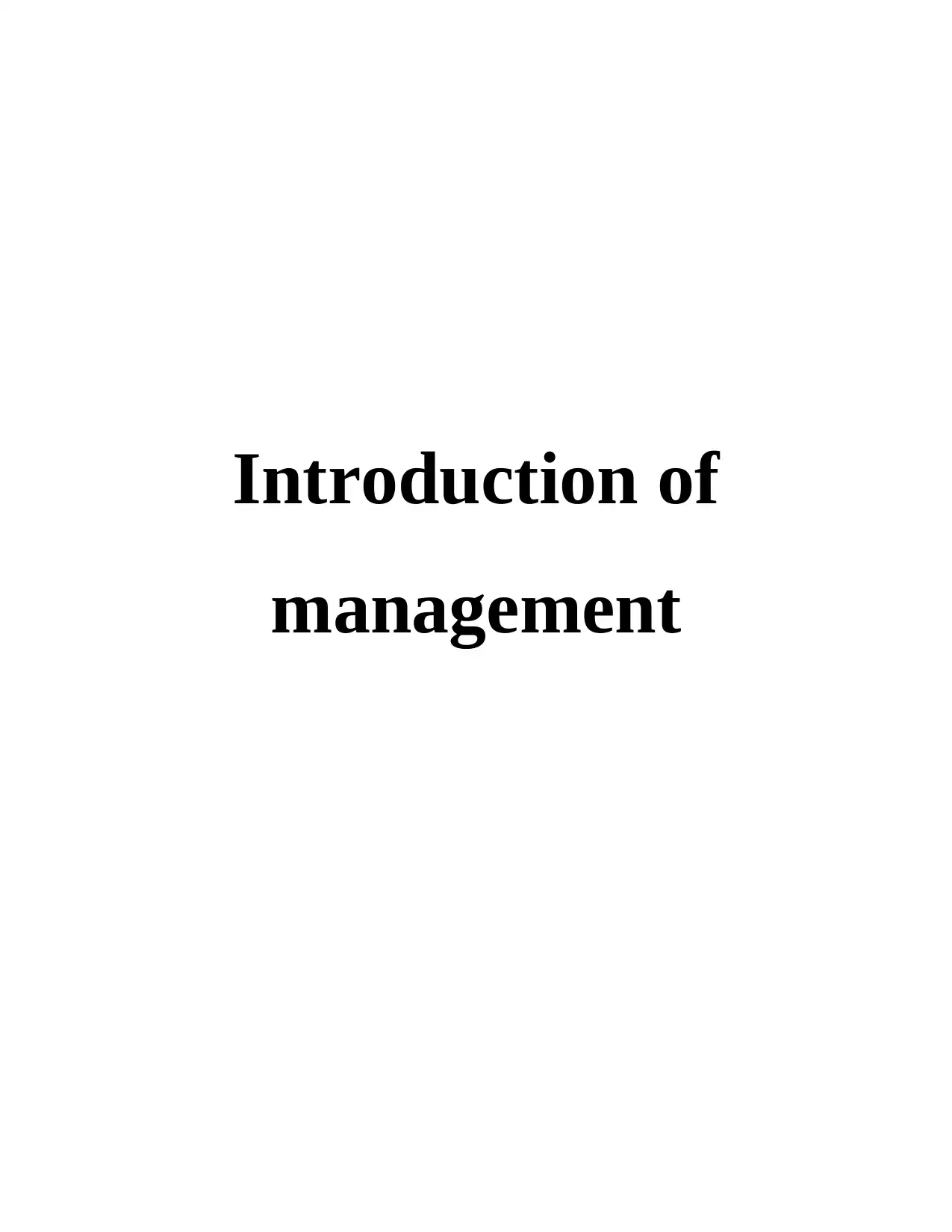
Introduction of
management
management
Paraphrase This Document
Need a fresh take? Get an instant paraphrase of this document with our AI Paraphraser
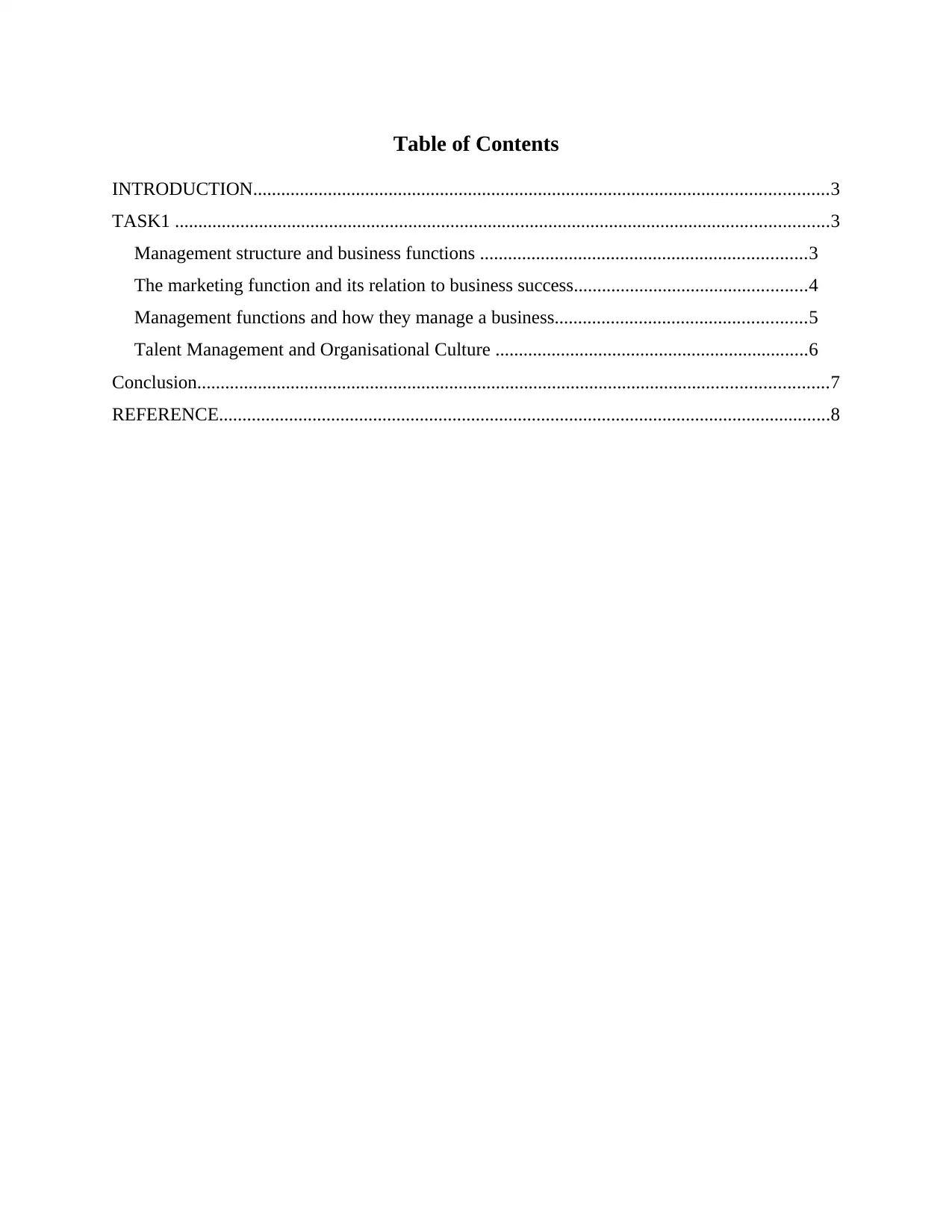
Table of Contents
INTRODUCTION...........................................................................................................................3
TASK1 ............................................................................................................................................3
Management structure and business functions ......................................................................3
The marketing function and its relation to business success..................................................4
Management functions and how they manage a business......................................................5
Talent Management and Organisational Culture ...................................................................6
Conclusion.......................................................................................................................................7
REFERENCE...................................................................................................................................8
INTRODUCTION...........................................................................................................................3
TASK1 ............................................................................................................................................3
Management structure and business functions ......................................................................3
The marketing function and its relation to business success..................................................4
Management functions and how they manage a business......................................................5
Talent Management and Organisational Culture ...................................................................6
Conclusion.......................................................................................................................................7
REFERENCE...................................................................................................................................8
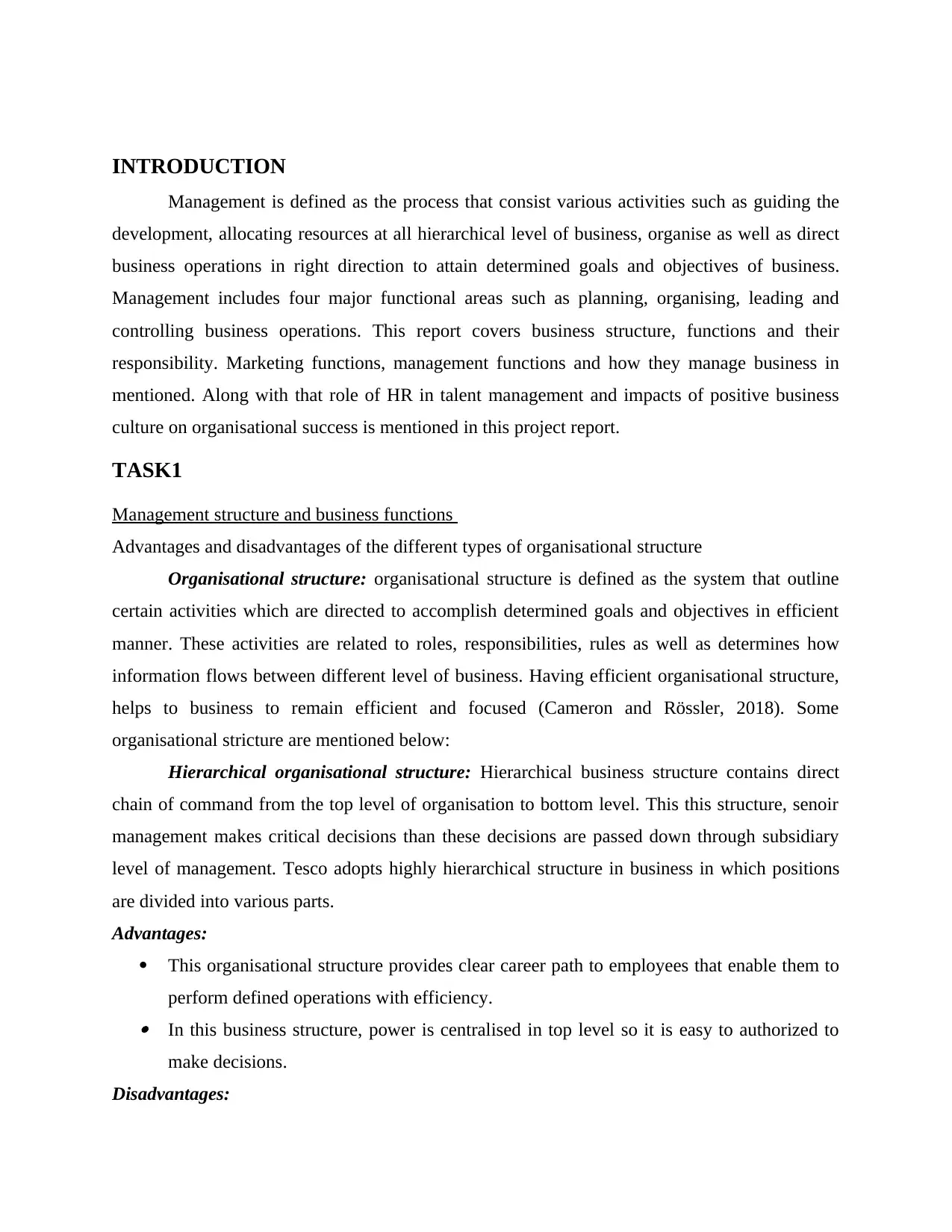
INTRODUCTION
Management is defined as the process that consist various activities such as guiding the
development, allocating resources at all hierarchical level of business, organise as well as direct
business operations in right direction to attain determined goals and objectives of business.
Management includes four major functional areas such as planning, organising, leading and
controlling business operations. This report covers business structure, functions and their
responsibility. Marketing functions, management functions and how they manage business in
mentioned. Along with that role of HR in talent management and impacts of positive business
culture on organisational success is mentioned in this project report.
TASK1
Management structure and business functions
Advantages and disadvantages of the different types of organisational structure
Organisational structure: organisational structure is defined as the system that outline
certain activities which are directed to accomplish determined goals and objectives in efficient
manner. These activities are related to roles, responsibilities, rules as well as determines how
information flows between different level of business. Having efficient organisational structure,
helps to business to remain efficient and focused (Cameron and Rössler, 2018). Some
organisational stricture are mentioned below:
Hierarchical organisational structure: Hierarchical business structure contains direct
chain of command from the top level of organisation to bottom level. This this structure, senoir
management makes critical decisions than these decisions are passed down through subsidiary
level of management. Tesco adopts highly hierarchical structure in business in which positions
are divided into various parts.
Advantages:
This organisational structure provides clear career path to employees that enable them to
perform defined operations with efficiency. In this business structure, power is centralised in top level so it is easy to authorized to
make decisions.
Disadvantages:
Management is defined as the process that consist various activities such as guiding the
development, allocating resources at all hierarchical level of business, organise as well as direct
business operations in right direction to attain determined goals and objectives of business.
Management includes four major functional areas such as planning, organising, leading and
controlling business operations. This report covers business structure, functions and their
responsibility. Marketing functions, management functions and how they manage business in
mentioned. Along with that role of HR in talent management and impacts of positive business
culture on organisational success is mentioned in this project report.
TASK1
Management structure and business functions
Advantages and disadvantages of the different types of organisational structure
Organisational structure: organisational structure is defined as the system that outline
certain activities which are directed to accomplish determined goals and objectives in efficient
manner. These activities are related to roles, responsibilities, rules as well as determines how
information flows between different level of business. Having efficient organisational structure,
helps to business to remain efficient and focused (Cameron and Rössler, 2018). Some
organisational stricture are mentioned below:
Hierarchical organisational structure: Hierarchical business structure contains direct
chain of command from the top level of organisation to bottom level. This this structure, senoir
management makes critical decisions than these decisions are passed down through subsidiary
level of management. Tesco adopts highly hierarchical structure in business in which positions
are divided into various parts.
Advantages:
This organisational structure provides clear career path to employees that enable them to
perform defined operations with efficiency. In this business structure, power is centralised in top level so it is easy to authorized to
make decisions.
Disadvantages:
⊘ This is a preview!⊘
Do you want full access?
Subscribe today to unlock all pages.

Trusted by 1+ million students worldwide
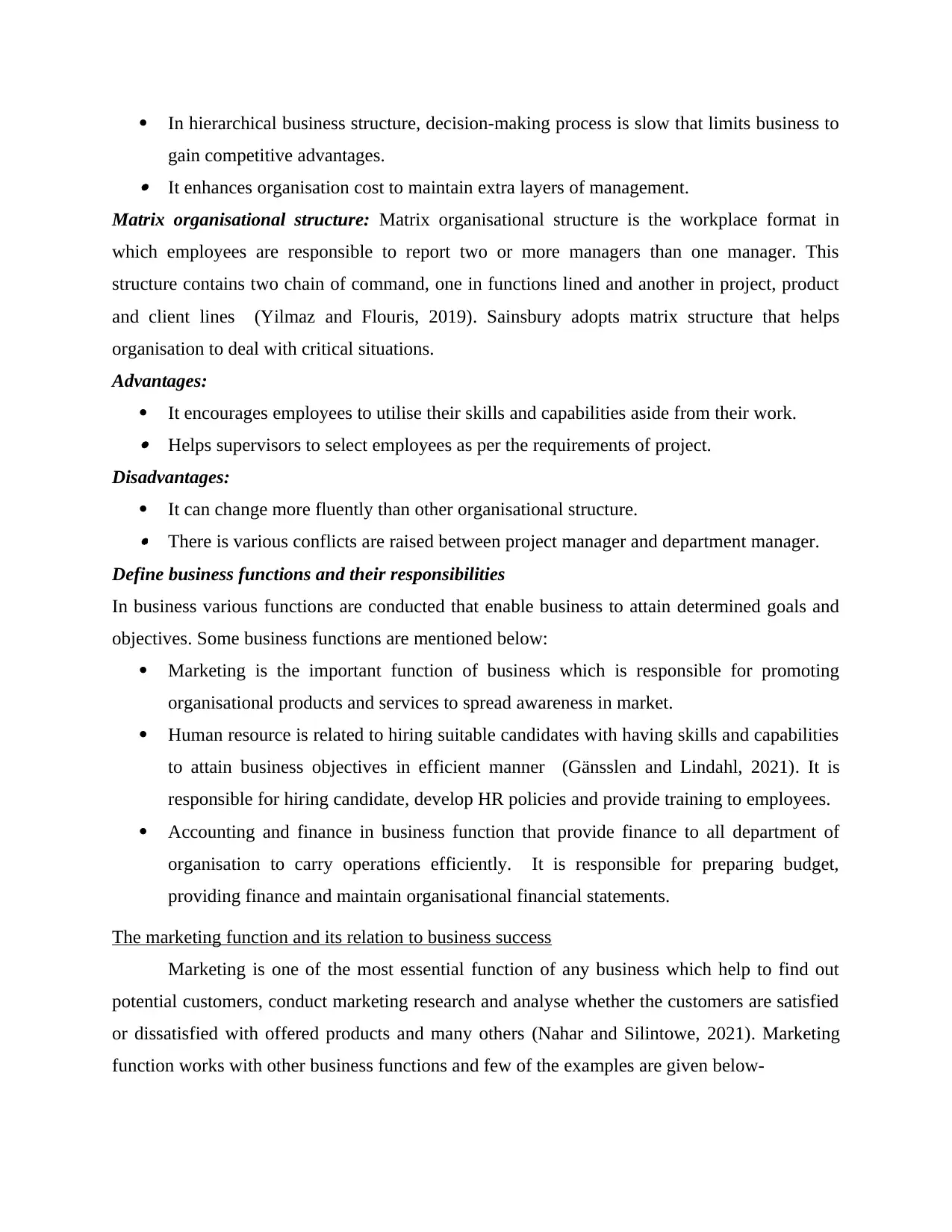
In hierarchical business structure, decision-making process is slow that limits business to
gain competitive advantages. It enhances organisation cost to maintain extra layers of management.
Matrix organisational structure: Matrix organisational structure is the workplace format in
which employees are responsible to report two or more managers than one manager. This
structure contains two chain of command, one in functions lined and another in project, product
and client lines (Yilmaz and Flouris, 2019). Sainsbury adopts matrix structure that helps
organisation to deal with critical situations.
Advantages:
It encourages employees to utilise their skills and capabilities aside from their work. Helps supervisors to select employees as per the requirements of project.
Disadvantages:
It can change more fluently than other organisational structure. There is various conflicts are raised between project manager and department manager.
Define business functions and their responsibilities
In business various functions are conducted that enable business to attain determined goals and
objectives. Some business functions are mentioned below:
Marketing is the important function of business which is responsible for promoting
organisational products and services to spread awareness in market.
Human resource is related to hiring suitable candidates with having skills and capabilities
to attain business objectives in efficient manner (Gänsslen and Lindahl, 2021). It is
responsible for hiring candidate, develop HR policies and provide training to employees.
Accounting and finance in business function that provide finance to all department of
organisation to carry operations efficiently. It is responsible for preparing budget,
providing finance and maintain organisational financial statements.
The marketing function and its relation to business success
Marketing is one of the most essential function of any business which help to find out
potential customers, conduct marketing research and analyse whether the customers are satisfied
or dissatisfied with offered products and many others (Nahar and Silintowe, 2021). Marketing
function works with other business functions and few of the examples are given below-
gain competitive advantages. It enhances organisation cost to maintain extra layers of management.
Matrix organisational structure: Matrix organisational structure is the workplace format in
which employees are responsible to report two or more managers than one manager. This
structure contains two chain of command, one in functions lined and another in project, product
and client lines (Yilmaz and Flouris, 2019). Sainsbury adopts matrix structure that helps
organisation to deal with critical situations.
Advantages:
It encourages employees to utilise their skills and capabilities aside from their work. Helps supervisors to select employees as per the requirements of project.
Disadvantages:
It can change more fluently than other organisational structure. There is various conflicts are raised between project manager and department manager.
Define business functions and their responsibilities
In business various functions are conducted that enable business to attain determined goals and
objectives. Some business functions are mentioned below:
Marketing is the important function of business which is responsible for promoting
organisational products and services to spread awareness in market.
Human resource is related to hiring suitable candidates with having skills and capabilities
to attain business objectives in efficient manner (Gänsslen and Lindahl, 2021). It is
responsible for hiring candidate, develop HR policies and provide training to employees.
Accounting and finance in business function that provide finance to all department of
organisation to carry operations efficiently. It is responsible for preparing budget,
providing finance and maintain organisational financial statements.
The marketing function and its relation to business success
Marketing is one of the most essential function of any business which help to find out
potential customers, conduct marketing research and analyse whether the customers are satisfied
or dissatisfied with offered products and many others (Nahar and Silintowe, 2021). Marketing
function works with other business functions and few of the examples are given below-
Paraphrase This Document
Need a fresh take? Get an instant paraphrase of this document with our AI Paraphraser
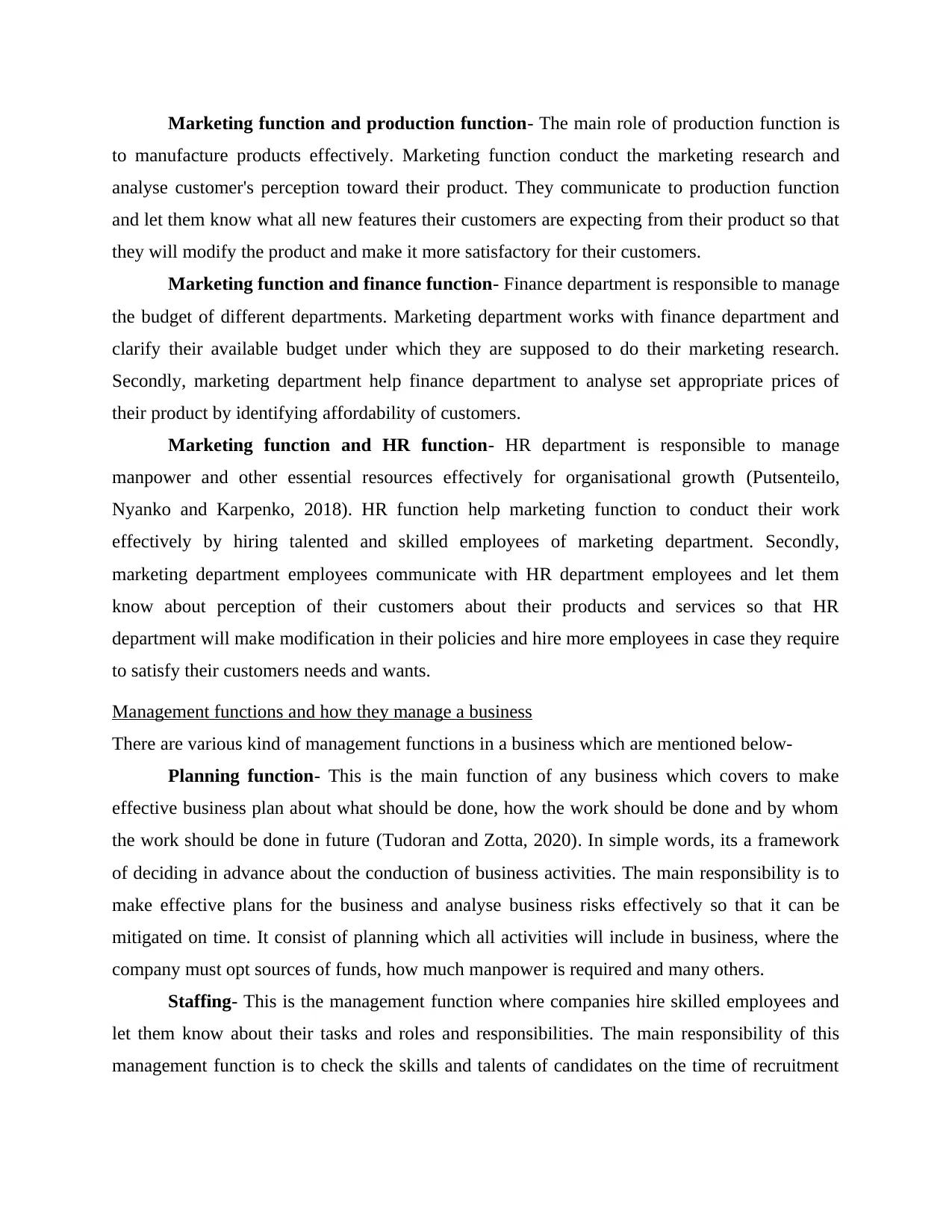
Marketing function and production function- The main role of production function is
to manufacture products effectively. Marketing function conduct the marketing research and
analyse customer's perception toward their product. They communicate to production function
and let them know what all new features their customers are expecting from their product so that
they will modify the product and make it more satisfactory for their customers.
Marketing function and finance function- Finance department is responsible to manage
the budget of different departments. Marketing department works with finance department and
clarify their available budget under which they are supposed to do their marketing research.
Secondly, marketing department help finance department to analyse set appropriate prices of
their product by identifying affordability of customers.
Marketing function and HR function- HR department is responsible to manage
manpower and other essential resources effectively for organisational growth (Putsenteilo,
Nyanko and Karpenko, 2018). HR function help marketing function to conduct their work
effectively by hiring talented and skilled employees of marketing department. Secondly,
marketing department employees communicate with HR department employees and let them
know about perception of their customers about their products and services so that HR
department will make modification in their policies and hire more employees in case they require
to satisfy their customers needs and wants.
Management functions and how they manage a business
There are various kind of management functions in a business which are mentioned below-
Planning function- This is the main function of any business which covers to make
effective business plan about what should be done, how the work should be done and by whom
the work should be done in future (Tudoran and Zotta, 2020). In simple words, its a framework
of deciding in advance about the conduction of business activities. The main responsibility is to
make effective plans for the business and analyse business risks effectively so that it can be
mitigated on time. It consist of planning which all activities will include in business, where the
company must opt sources of funds, how much manpower is required and many others.
Staffing- This is the management function where companies hire skilled employees and
let them know about their tasks and roles and responsibilities. The main responsibility of this
management function is to check the skills and talents of candidates on the time of recruitment
to manufacture products effectively. Marketing function conduct the marketing research and
analyse customer's perception toward their product. They communicate to production function
and let them know what all new features their customers are expecting from their product so that
they will modify the product and make it more satisfactory for their customers.
Marketing function and finance function- Finance department is responsible to manage
the budget of different departments. Marketing department works with finance department and
clarify their available budget under which they are supposed to do their marketing research.
Secondly, marketing department help finance department to analyse set appropriate prices of
their product by identifying affordability of customers.
Marketing function and HR function- HR department is responsible to manage
manpower and other essential resources effectively for organisational growth (Putsenteilo,
Nyanko and Karpenko, 2018). HR function help marketing function to conduct their work
effectively by hiring talented and skilled employees of marketing department. Secondly,
marketing department employees communicate with HR department employees and let them
know about perception of their customers about their products and services so that HR
department will make modification in their policies and hire more employees in case they require
to satisfy their customers needs and wants.
Management functions and how they manage a business
There are various kind of management functions in a business which are mentioned below-
Planning function- This is the main function of any business which covers to make
effective business plan about what should be done, how the work should be done and by whom
the work should be done in future (Tudoran and Zotta, 2020). In simple words, its a framework
of deciding in advance about the conduction of business activities. The main responsibility is to
make effective plans for the business and analyse business risks effectively so that it can be
mitigated on time. It consist of planning which all activities will include in business, where the
company must opt sources of funds, how much manpower is required and many others.
Staffing- This is the management function where companies hire skilled employees and
let them know about their tasks and roles and responsibilities. The main responsibility of this
management function is to check the skills and talents of candidates on the time of recruitment
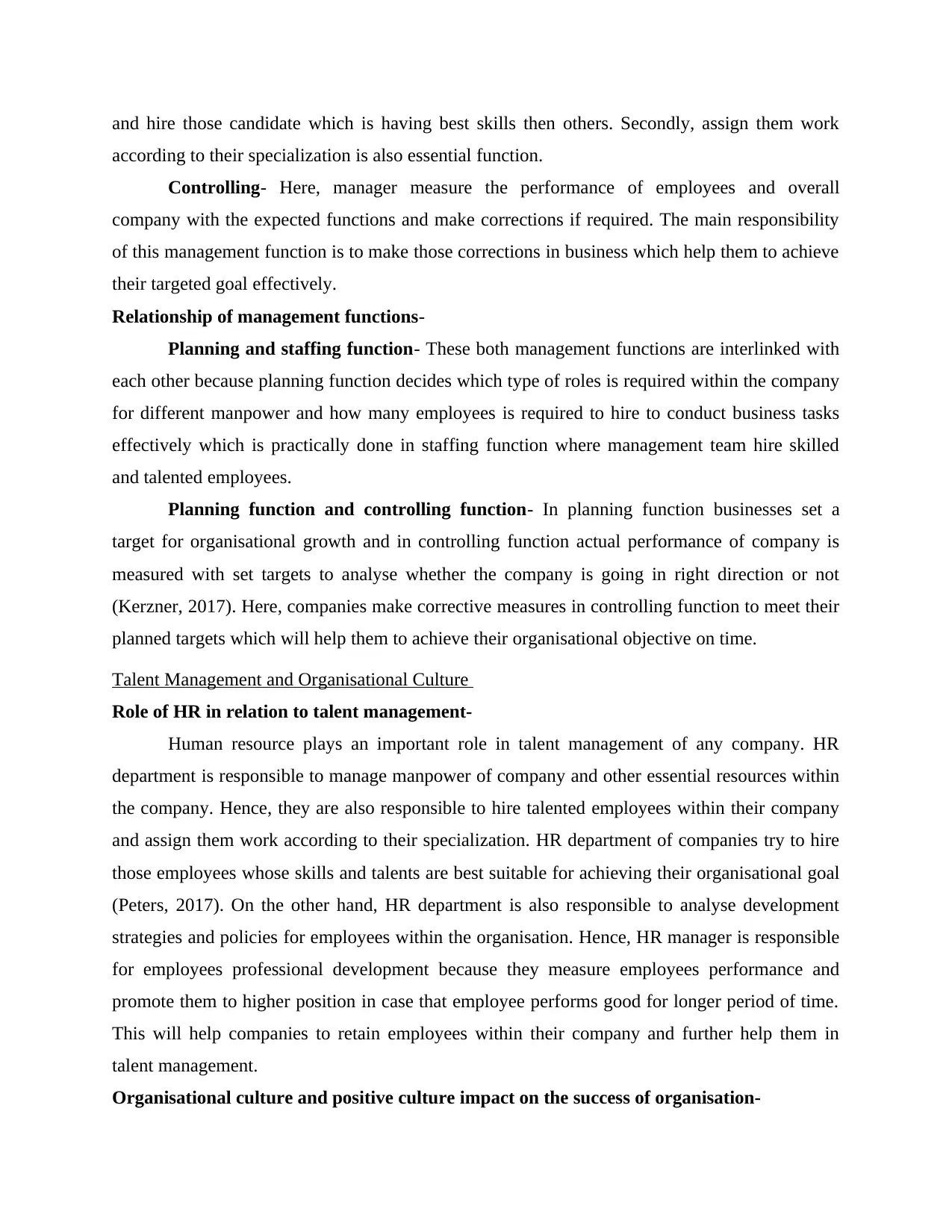
and hire those candidate which is having best skills then others. Secondly, assign them work
according to their specialization is also essential function.
Controlling- Here, manager measure the performance of employees and overall
company with the expected functions and make corrections if required. The main responsibility
of this management function is to make those corrections in business which help them to achieve
their targeted goal effectively.
Relationship of management functions-
Planning and staffing function- These both management functions are interlinked with
each other because planning function decides which type of roles is required within the company
for different manpower and how many employees is required to hire to conduct business tasks
effectively which is practically done in staffing function where management team hire skilled
and talented employees.
Planning function and controlling function- In planning function businesses set a
target for organisational growth and in controlling function actual performance of company is
measured with set targets to analyse whether the company is going in right direction or not
(Kerzner, 2017). Here, companies make corrective measures in controlling function to meet their
planned targets which will help them to achieve their organisational objective on time.
Talent Management and Organisational Culture
Role of HR in relation to talent management-
Human resource plays an important role in talent management of any company. HR
department is responsible to manage manpower of company and other essential resources within
the company. Hence, they are also responsible to hire talented employees within their company
and assign them work according to their specialization. HR department of companies try to hire
those employees whose skills and talents are best suitable for achieving their organisational goal
(Peters, 2017). On the other hand, HR department is also responsible to analyse development
strategies and policies for employees within the organisation. Hence, HR manager is responsible
for employees professional development because they measure employees performance and
promote them to higher position in case that employee performs good for longer period of time.
This will help companies to retain employees within their company and further help them in
talent management.
Organisational culture and positive culture impact on the success of organisation-
according to their specialization is also essential function.
Controlling- Here, manager measure the performance of employees and overall
company with the expected functions and make corrections if required. The main responsibility
of this management function is to make those corrections in business which help them to achieve
their targeted goal effectively.
Relationship of management functions-
Planning and staffing function- These both management functions are interlinked with
each other because planning function decides which type of roles is required within the company
for different manpower and how many employees is required to hire to conduct business tasks
effectively which is practically done in staffing function where management team hire skilled
and talented employees.
Planning function and controlling function- In planning function businesses set a
target for organisational growth and in controlling function actual performance of company is
measured with set targets to analyse whether the company is going in right direction or not
(Kerzner, 2017). Here, companies make corrective measures in controlling function to meet their
planned targets which will help them to achieve their organisational objective on time.
Talent Management and Organisational Culture
Role of HR in relation to talent management-
Human resource plays an important role in talent management of any company. HR
department is responsible to manage manpower of company and other essential resources within
the company. Hence, they are also responsible to hire talented employees within their company
and assign them work according to their specialization. HR department of companies try to hire
those employees whose skills and talents are best suitable for achieving their organisational goal
(Peters, 2017). On the other hand, HR department is also responsible to analyse development
strategies and policies for employees within the organisation. Hence, HR manager is responsible
for employees professional development because they measure employees performance and
promote them to higher position in case that employee performs good for longer period of time.
This will help companies to retain employees within their company and further help them in
talent management.
Organisational culture and positive culture impact on the success of organisation-
⊘ This is a preview!⊘
Do you want full access?
Subscribe today to unlock all pages.

Trusted by 1+ million students worldwide
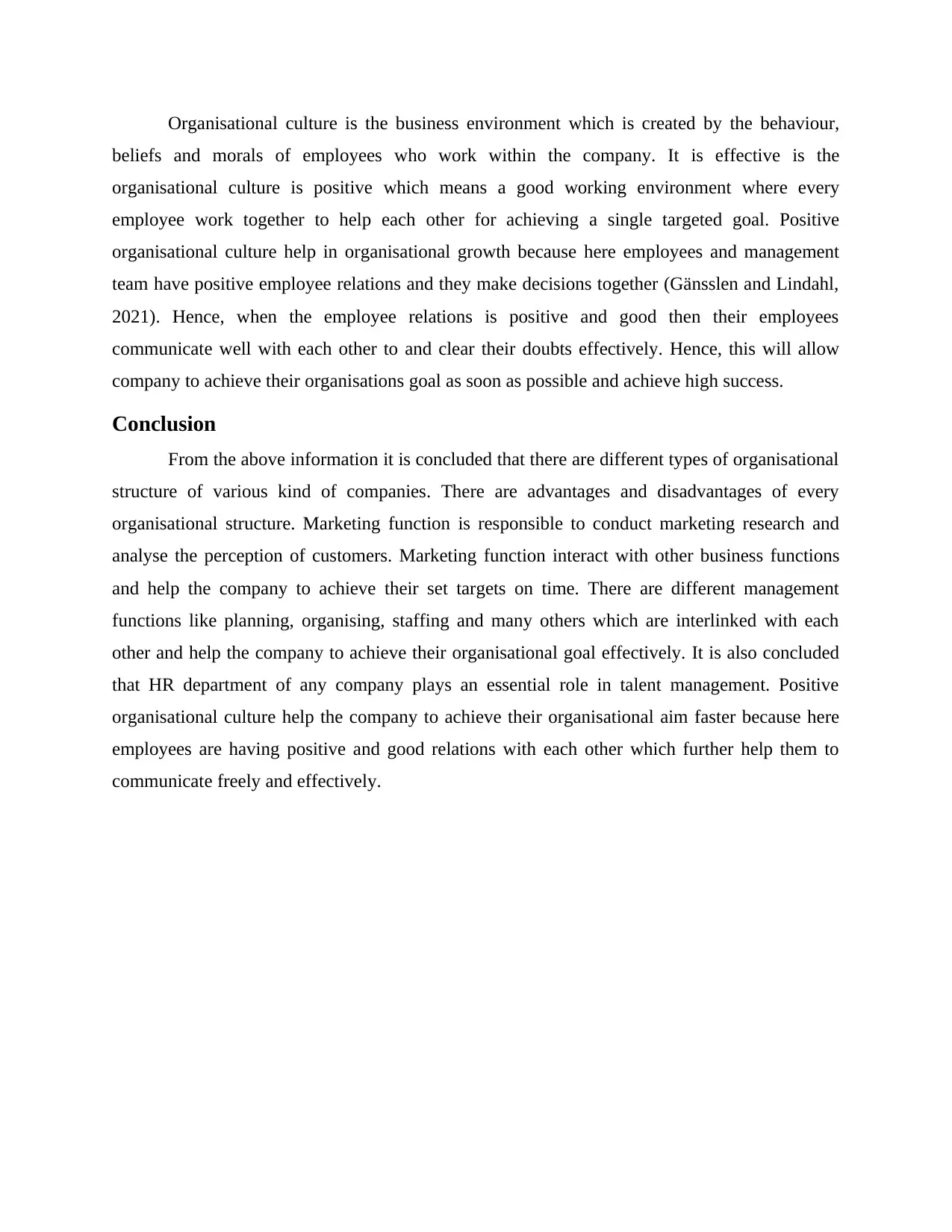
Organisational culture is the business environment which is created by the behaviour,
beliefs and morals of employees who work within the company. It is effective is the
organisational culture is positive which means a good working environment where every
employee work together to help each other for achieving a single targeted goal. Positive
organisational culture help in organisational growth because here employees and management
team have positive employee relations and they make decisions together (Gänsslen and Lindahl,
2021). Hence, when the employee relations is positive and good then their employees
communicate well with each other to and clear their doubts effectively. Hence, this will allow
company to achieve their organisations goal as soon as possible and achieve high success.
Conclusion
From the above information it is concluded that there are different types of organisational
structure of various kind of companies. There are advantages and disadvantages of every
organisational structure. Marketing function is responsible to conduct marketing research and
analyse the perception of customers. Marketing function interact with other business functions
and help the company to achieve their set targets on time. There are different management
functions like planning, organising, staffing and many others which are interlinked with each
other and help the company to achieve their organisational goal effectively. It is also concluded
that HR department of any company plays an essential role in talent management. Positive
organisational culture help the company to achieve their organisational aim faster because here
employees are having positive and good relations with each other which further help them to
communicate freely and effectively.
beliefs and morals of employees who work within the company. It is effective is the
organisational culture is positive which means a good working environment where every
employee work together to help each other for achieving a single targeted goal. Positive
organisational culture help in organisational growth because here employees and management
team have positive employee relations and they make decisions together (Gänsslen and Lindahl,
2021). Hence, when the employee relations is positive and good then their employees
communicate well with each other to and clear their doubts effectively. Hence, this will allow
company to achieve their organisations goal as soon as possible and achieve high success.
Conclusion
From the above information it is concluded that there are different types of organisational
structure of various kind of companies. There are advantages and disadvantages of every
organisational structure. Marketing function is responsible to conduct marketing research and
analyse the perception of customers. Marketing function interact with other business functions
and help the company to achieve their set targets on time. There are different management
functions like planning, organising, staffing and many others which are interlinked with each
other and help the company to achieve their organisational goal effectively. It is also concluded
that HR department of any company plays an essential role in talent management. Positive
organisational culture help the company to achieve their organisational aim faster because here
employees are having positive and good relations with each other which further help them to
communicate freely and effectively.
Paraphrase This Document
Need a fresh take? Get an instant paraphrase of this document with our AI Paraphraser
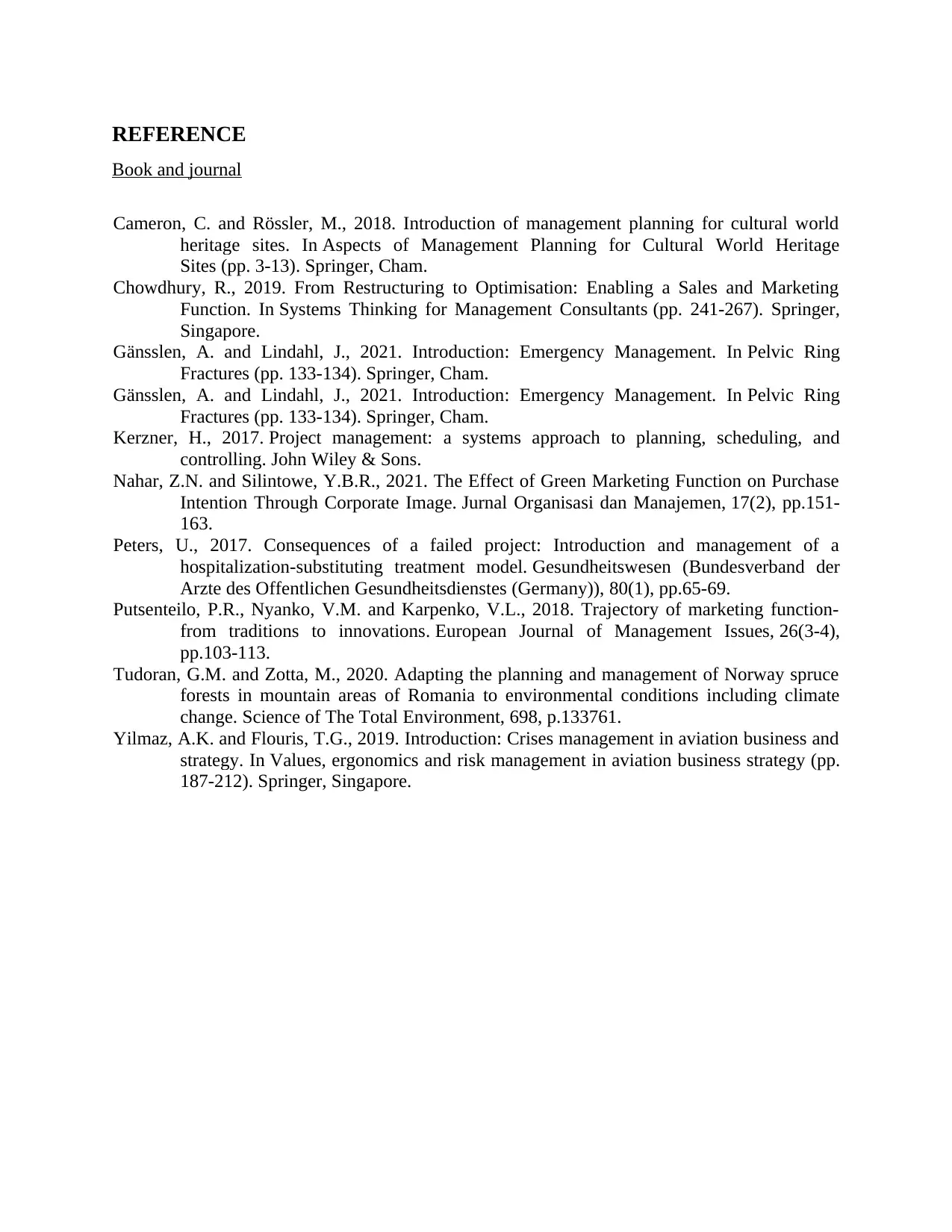
REFERENCE
Book and journal
Cameron, C. and Rössler, M., 2018. Introduction of management planning for cultural world
heritage sites. In Aspects of Management Planning for Cultural World Heritage
Sites (pp. 3-13). Springer, Cham.
Chowdhury, R., 2019. From Restructuring to Optimisation: Enabling a Sales and Marketing
Function. In Systems Thinking for Management Consultants (pp. 241-267). Springer,
Singapore.
Gänsslen, A. and Lindahl, J., 2021. Introduction: Emergency Management. In Pelvic Ring
Fractures (pp. 133-134). Springer, Cham.
Gänsslen, A. and Lindahl, J., 2021. Introduction: Emergency Management. In Pelvic Ring
Fractures (pp. 133-134). Springer, Cham.
Kerzner, H., 2017. Project management: a systems approach to planning, scheduling, and
controlling. John Wiley & Sons.
Nahar, Z.N. and Silintowe, Y.B.R., 2021. The Effect of Green Marketing Function on Purchase
Intention Through Corporate Image. Jurnal Organisasi dan Manajemen, 17(2), pp.151-
163.
Peters, U., 2017. Consequences of a failed project: Introduction and management of a
hospitalization-substituting treatment model. Gesundheitswesen (Bundesverband der
Arzte des Offentlichen Gesundheitsdienstes (Germany)), 80(1), pp.65-69.
Putsenteilo, P.R., Nyanko, V.M. and Karpenko, V.L., 2018. Trajectory of marketing function-
from traditions to innovations. European Journal of Management Issues, 26(3-4),
pp.103-113.
Tudoran, G.M. and Zotta, M., 2020. Adapting the planning and management of Norway spruce
forests in mountain areas of Romania to environmental conditions including climate
change. Science of The Total Environment, 698, p.133761.
Yilmaz, A.K. and Flouris, T.G., 2019. Introduction: Crises management in aviation business and
strategy. In Values, ergonomics and risk management in aviation business strategy (pp.
187-212). Springer, Singapore.
Book and journal
Cameron, C. and Rössler, M., 2018. Introduction of management planning for cultural world
heritage sites. In Aspects of Management Planning for Cultural World Heritage
Sites (pp. 3-13). Springer, Cham.
Chowdhury, R., 2019. From Restructuring to Optimisation: Enabling a Sales and Marketing
Function. In Systems Thinking for Management Consultants (pp. 241-267). Springer,
Singapore.
Gänsslen, A. and Lindahl, J., 2021. Introduction: Emergency Management. In Pelvic Ring
Fractures (pp. 133-134). Springer, Cham.
Gänsslen, A. and Lindahl, J., 2021. Introduction: Emergency Management. In Pelvic Ring
Fractures (pp. 133-134). Springer, Cham.
Kerzner, H., 2017. Project management: a systems approach to planning, scheduling, and
controlling. John Wiley & Sons.
Nahar, Z.N. and Silintowe, Y.B.R., 2021. The Effect of Green Marketing Function on Purchase
Intention Through Corporate Image. Jurnal Organisasi dan Manajemen, 17(2), pp.151-
163.
Peters, U., 2017. Consequences of a failed project: Introduction and management of a
hospitalization-substituting treatment model. Gesundheitswesen (Bundesverband der
Arzte des Offentlichen Gesundheitsdienstes (Germany)), 80(1), pp.65-69.
Putsenteilo, P.R., Nyanko, V.M. and Karpenko, V.L., 2018. Trajectory of marketing function-
from traditions to innovations. European Journal of Management Issues, 26(3-4),
pp.103-113.
Tudoran, G.M. and Zotta, M., 2020. Adapting the planning and management of Norway spruce
forests in mountain areas of Romania to environmental conditions including climate
change. Science of The Total Environment, 698, p.133761.
Yilmaz, A.K. and Flouris, T.G., 2019. Introduction: Crises management in aviation business and
strategy. In Values, ergonomics and risk management in aviation business strategy (pp.
187-212). Springer, Singapore.
1 out of 8
Related Documents
Your All-in-One AI-Powered Toolkit for Academic Success.
+13062052269
info@desklib.com
Available 24*7 on WhatsApp / Email
![[object Object]](/_next/static/media/star-bottom.7253800d.svg)
Unlock your academic potential
Copyright © 2020–2025 A2Z Services. All Rights Reserved. Developed and managed by ZUCOL.




